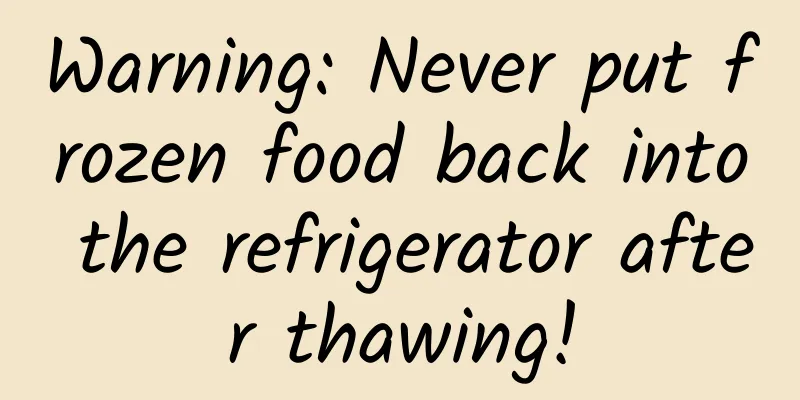Warning: Never put frozen food back into the refrigerator after thawing!

|
During the Spring Festival holiday, you may have had the following experience: you thawed a pack of quick-frozen shrimps, but only needed a small portion for cooking, so you put the rest in the freezer and refrozen it for next time. In fact, this is not a good practice. 01 Quick Freeze: This winter is not too cold The so-called quick freezing, as the name implies, is rapid freezing. By lowering the temperature and water activity, various chemical reactions are inhibited and the deterioration of food is delayed. The quick freezing process involves the crystallization of water molecules. In short, the slower the cooling rate, the larger the ice crystals formed by water molecules. Therefore, the purpose of rapid cooling is to make the ice crystals formed by water as small as possible so as not to destroy the integrity of the microstructure of the food as much as possible. In fact, if the cooling rate is fast enough (for example, using liquid nitrogen to quickly cool down to below -135 degrees Celsius), water will exist in a state of high viscosity liquid without ice crystals at all. However, this technology is usually only used to freeze "essence" resources such as sperm and eggs, and is unlikely to be applied to food - firstly, the food is too large to quickly reduce the core temperature; secondly, the cost of such rapid cooling is too high. Copyright image, no permission to reprint So how fast is "quick freezing" in food processing, and how low is the temperature? The general requirement is to reduce the temperature of the center of the food to about -5 degrees Celsius within 30 minutes, and then store it in an environment of -18 degrees Celsius. Since the diameter of the ice crystals produced by quick freezing is less than 100 microns, which is exactly the same size as the diameter of most animal cells (10-100 microns), the ice crystals will destroy the structure of the cell membrane in the food. This is one of the reasons why quick-frozen food does not taste as good as fresh food. However, these ice crystals can hardly harm smaller bacteria (about 0.5-5 microns in diameter), which means that such temperatures cannot freeze the bacteria to death. They just temporarily enter a hibernation state due to the decrease in temperature and water activity. 02 Thaw: Spring in the Bacteria Class Except for a few cold drinks such as ice cream, most foods still need to be thawed, reheated, or even cooked at high temperatures before they can be eaten (what? You have good teeth? You love to eat frozen hairtail?). So two important changes will occur during the thawing process: one is the increase in temperature, and the other is the increase in water activity. Copyright image, no permission to reprint When a pile of hairtail at -18 degrees Celsius is heated up to room temperature, as the temperature and water activity increase, various chemical reactions that can cause food spoilage are gradually accelerated, and the bacteria that were originally in a hibernating state also wake up as if spring has arrived. Guess what the first thing the bacteria see when they wake up? Because the cell membrane is destroyed by ice crystals during the freezing process, the cell fluid flows out after thawing. For bacteria, it is no different from a person who is about to faint from hunger suddenly seeing the fragrant and tempting boiled pork slices and the greasy roasted chicken legs. Moreover, the ancients said that when you are full and warm, you will think about sex, and this is no exception for bacteria. What's more terrifying is that bacteria reproduce exponentially. At room temperature, it only takes a few hours for the number of bacteria in this pile of hairtail to multiply several times. If you quickly cook it into braised hairtail and eat it, it won’t cause health problems. However, if you put it back in the refrigerator, it usually takes several hours for the food to be completely frozen from the inside out, as the freezing effect of ordinary household refrigerators is limited. Bacteria will still use this time to increase the “population base” of “class members”. In addition, this slow freezing process will form larger ice crystals, causing further damage to hairtail cells. When it is thawed next time, due to the larger bacterial “population base” and more severely damaged hairtail cells, this pile of twice frozen, miserable hairtail will be more likely to deteriorate in a short period of time. The consequence of rashly eating this miserable hairtail is likely to run to the bathroom with your hands on your stomach, and it may be multiple times! Copyright image, no permission to reprint Refreezing thawed food is not conducive to food preservation and will increase the risk of food spoilage, so thawed food should be eaten in one go. For the safety of consumers, the EU stipulates that all quick-frozen food packaging must be clearly marked with "Do not refreeze thawed food". Author: One less screw Source: Guokr The cover image and the images in this article are from the copyright library Reproduction of image content is not authorized |
<<: Why can't the cyclamen I grow with five rabbit ears bloom?
>>: Who opened the first page of the book of the Qinghai-Tibet Plateau’s stratigraphic structure?
Recommend
How to use mind mapping in product operations?
Mind mapping, as a tool, is now used in all walks...
If you want users to actively help you spread the word, please do these things first!
When doing operations , one of the most important...
SAIC postpones plans to enter the US; GAC may enter the US in 2019
According to Bloomberg, SAIC Motor has suspended ...
Three typhoons "dance together", and typhoon red warnings continue to be issued!
Typhoon Saura, the ninth typhoon this year At aro...
Still eating and drinking as you please? Be careful to "pick" out colon cancer...Have you fallen into these eating habits?
Our physical health is closely related to our eat...
The latest news on the Nanjing epidemic: Can outsiders enter Wuxi now?
Wu Guo: I am from Xuzhou, Jiangsu. My child’s sch...
Have you been fooled by wearable devices?
There have always been different opinions about t...
Detailed strategy | How to use resources to boost homepage traffic?
In this article, we will continue to talk about h...
How much does it cost to produce the Yulin bargaining app? How much does it cost to develop the Yulin bargaining mini program?
How much does it cost to produce the Yulin bargai...
The Tonga volcano erupted, and satellites from various countries released shocking pictures. Why are we so low-key?
The Tonga volcano eruption caused a huge disaster...
APICloud CEO Liu Xin: Let’s talk about the future of Web App and Native App
Author APICloud Liu Xin's previous article &q...
Implementing system sound recording in Android-RK3399 development board source code modification
Preface I have been recording system sound these ...
User Growth Tips
The background for writing this article is due to...
How to achieve growth at low prices? Let you know Xiaomi's business model
How to achieve growth at low prices? How to make ...
How to operate a brand well? Practical skills in brand operation!
Many people in companies who are in charge of bra...









